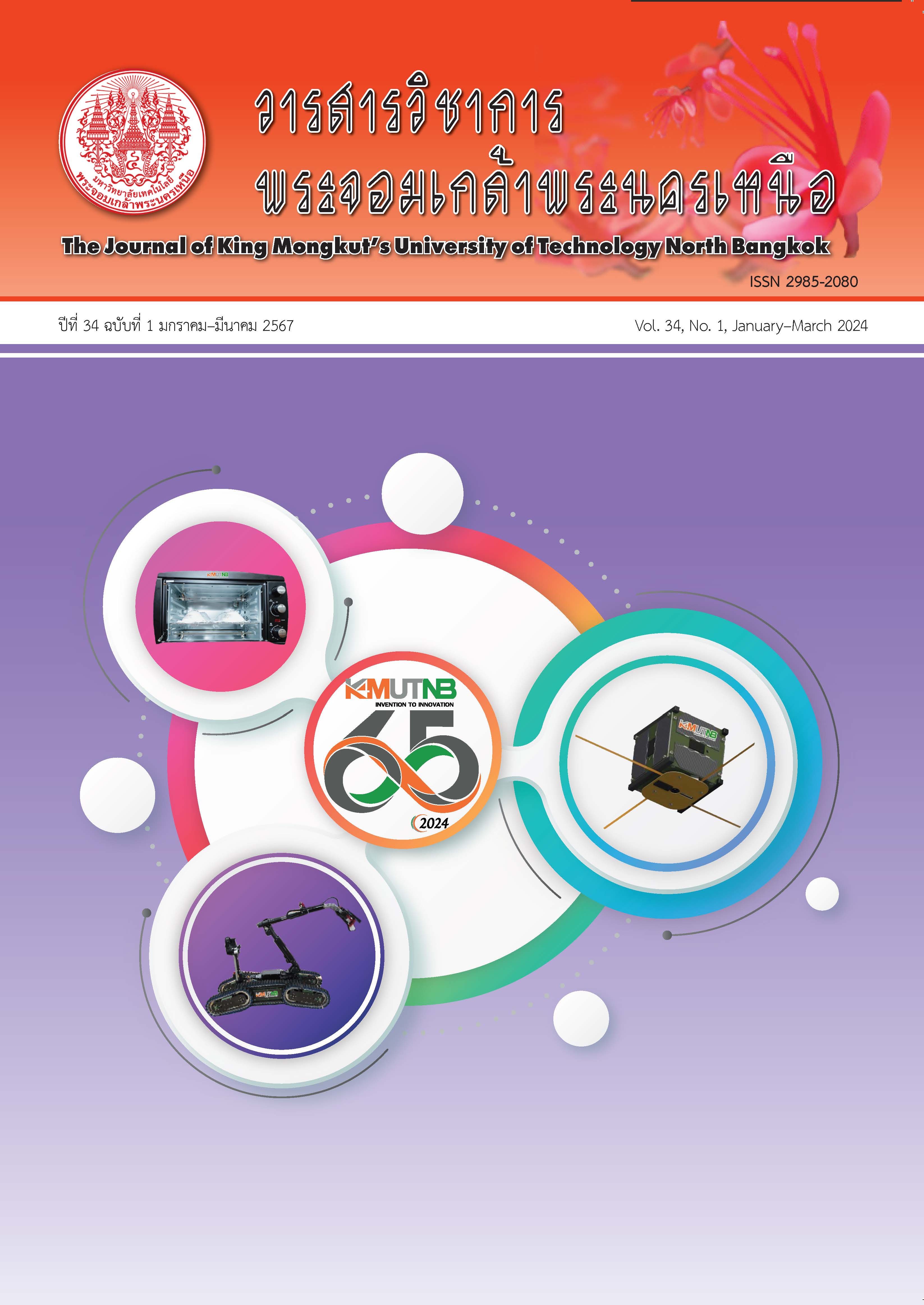การศึกษาปัจจัยของการกำจัดเชื้อแบคทีเรียด้วยพลาสมาระบบไดอิเล็กทริคแบริเออร์ดิสชาร์จบนกรรไกรผ่าตัด
Main Article Content
บทคัดย่อ
การปนเปื้อนเชื้อโรคบนพื้นผิวของอุปกรณ์ทางการแพทย์ส่งผลต่อการติดเชื้อในระหว่างการทำหัตถการ ดังนั้นทางคณะผู้วิจัยทำการวิจัยกำจัดเชื้อบนพื้นผิวเครื่องมือแพทย์โดยใช้พลาสมาที่มาจากระบบไดอิเล็กทริคแบร์ริเออร์ดิจชาร์จ (Dielectric barrier discharge plasma : DBD plasma) บนพื้นผิวเครื่องมือแพทย์ตัวอย่างนั่นคือ กรรไกรผ่าตัดขนาดเล็ก งานวิจัยนี้ศึกษาตัวแปรที่มีผลต่อการกำจัดเชื้อ ได้แก่ ศักย์ไฟฟ้าที่ให้แก่ระบบซึ่งเพิ่มขึ้นทีละ 1 กิโลโวลต์ โดยทำการทดสอบทั้งหมด 3 ค่า ได้แก่ 6 กิโลโวลต์ 7 กิโลโวลต์ และ 8 กิโลโวลต์ ตามลำดับ และเวลาที่พื้นผิววัสดุสัมผัสพลาสมา ได้แก่ เวลา 1 นาที 3 นาที และ 5 นาที ตามลำดับ ในการทดลองกำหนดให้ระยะห่างระหว่างผิววัสดุกับขั้วไฟฟ้ามีค่าคงที่ งานวิจัยนี้เชื้อที่นำมาทดสอบ คือ เชื้อบนฝ่ามือที่ได้รับการเพาะเชื้อบนจานเพาะเชื้อ เชื้อดังกล่าวที่ถูกทดสอบในแต่ละเงื่อนไข หลังจากการทดลองเชื้อดังกล่าวถูกเพาะและทิ้งไว้เป็นเวลา 3 วัน หลังจากนั้นจึง สังเกตผล จากผลการทดลองพบว่าศักย์ไฟฟ้ที่สูงขึ้นและเวลาที่พลาสมาสัมผัสผิวของวัสดุที่มากขึ้นส่งผลต่อประสิทธิภาพในการกำจัดเชื้อของพลาสมาที่มากขึ้นเช่นกัน
Article Details

อนุญาตภายใต้เงื่อนไข Creative Commons Attribution-NonCommercial-NoDerivatives 4.0 International License.
บทความที่ลงตีพิมพ์เป็นข้อคิดเห็นของผู้เขียนเท่านั้น
ผู้เขียนจะต้องเป็นผู้รับผิดชอบต่อผลทางกฎหมายใดๆ ที่อาจเกิดขึ้นจากบทความนั้น
เอกสารอ้างอิง
J. F. Gardner and M. M. Peel, Introduction to sterilization, disinfection and infection control, 2nd ed. Melbourne, Australia: Churchill Livingstone, 1991.
M. Somumchan, “Medical equipment sterilization using plasma system,” M.S. thesis, Department of Electrical Technology Education, Faculty of Industrial Education and Technology, King Mongkut's University of Technology Thonburi, 2012 (in Thai).
S. Janthima, C. Sawangrat, T. Boonyawan, S. Lumyong, J. Kumla, and N. Suwannarach, “Appropriate parameters of plasma activated water for growth inhibition of E. coli by Box- Behnken design),” Engineering Journal Chiang Mai University, vol. 26, no. 2, pp. 179–189, 2019 (in Thai).
K. Kartaschew, S. Baldus, M. Mischo, E. Bründermann, P. Awakowicz, and M. Havenith, “Cold atmospheric-pressure plasma and bacteria: Understanding the mode of action using vibrational microspectroscopy,” Journal of Physics D: Applied Physics, vol. 49, 2016.
J. U. Neuber, “Non-thermal atmosphericpressure plasma for sterilization of surfaces and biofilms,” M.S. thesis, Department of Electrical & Computer Engineering, Batten College of Engineering & Technology, Old Dominion University, 2016.
I. J. Moon and C. H. Won, “Review of the current state of medical plasma technology and its potential applications,” Medical Lasers, vol. 7, no. 1, pp. 1–5, 2018.
N. Mastanaiah, “Dielectric Barrier Discharge (DBD) plasma sterilization: An in-depth study of the factors contributing to and enhancing the sterilization process,” Ph.D. dissertion, University of Florida, 2013.
L. G. Holmlund, “Steam corrosion and steam corrosion inhibition in autoclave sterilization of dental and surgical steel materials,” Biotechnology and Bioengineering, vol. 7, no. 1, pp. 177–198, 1965.
R. L. Bertolotti and V. Hurst, “Inhibition of corrosion during autoclave sterilization of carbon steel dental instruments,” The Journal of the American Dental Association, vol. 97, no. 4, pp. 628–632, 1978.
W. Tian and M. J. Kushner, “Atmospheric pressure dielectric barrier discharges interacting with liquid covered tissue,” Journal of Physics D: Applied Physics, vol. 47, no. 16, 2014.
M. Moreau, N. Orange, and M. G. J. Feuilloley, “Non-thermal plasma technologies: New tools for bio-decontamination,” Biotechnology Advances, vol. 26, no. 6, pp. 610–617, 2008.
D. Butscher, H. V. Loon, A. Waskow, P. R. von Rohr, and M. Schuppler, “Plasma inactivation of microorganisms on sprout seeds in a dielectric barrier discharge,” International Journal of Food Microbiology, vol. 238, pp. 222–232, 2016.
V. Štěpánová, P. Slavíček, J. Kelar, J. Prášil, M. Smékal, M. Stupavská, J. Jurmanová, and M. Černák, “Atmospheric pressure plasma treatment of agricultural seeds of cucumber (Cucumis sativus L.) and pepper (Capsicum annuum L.) with effect on reduction of diseases and germination improvement,” Plasma Processes and Polymers, vol. 15, no. 2, 2018.
J. M. Boiano and A. L. Steege. (2015, Jan.). Ethylene Oxide and Hydrogen Peroxide Gas Plasma Sterilization: Precautionary Practices in U.S. Hospitals. Zentralsterilisation (Wiesb). [Online]. 23(4), pp. 262–268. Available: https:// pubmed.ncbi.nlm.nih.gov/26594097/
B. Choudhury, S. Portugal, N. Mastanaiah, J. A. Johnson, and S. Roy, “Inactivation of Pseudomonas aeruginosa and Methicillinresistant Staphylococcus aureus in an open water system with ozone generated by a compact, atmospheric DBD plasma reactor,” Scientific Reports, vol. 8, no. 1, 2018.
H. Ghomi, S. Mohades, N. Navab Safa, and H. Dabiri. (2012, June). Surface Decontamination by Dielectric Barrier Discharge Plasma. Journal of Biomedical Physics and Engineering. [Online]. 2(2), Available: https://jbpe.sums. ac.ir/article_43034.html
A. Sakudo, Y. Yagyu, and T. Onodera, “Disinfection and sterilization using plasma technology: Fundamentals and future perspectives for biological applications,” International Journal of Molecular Sciences, vol. 20, no. 20, 2019.

